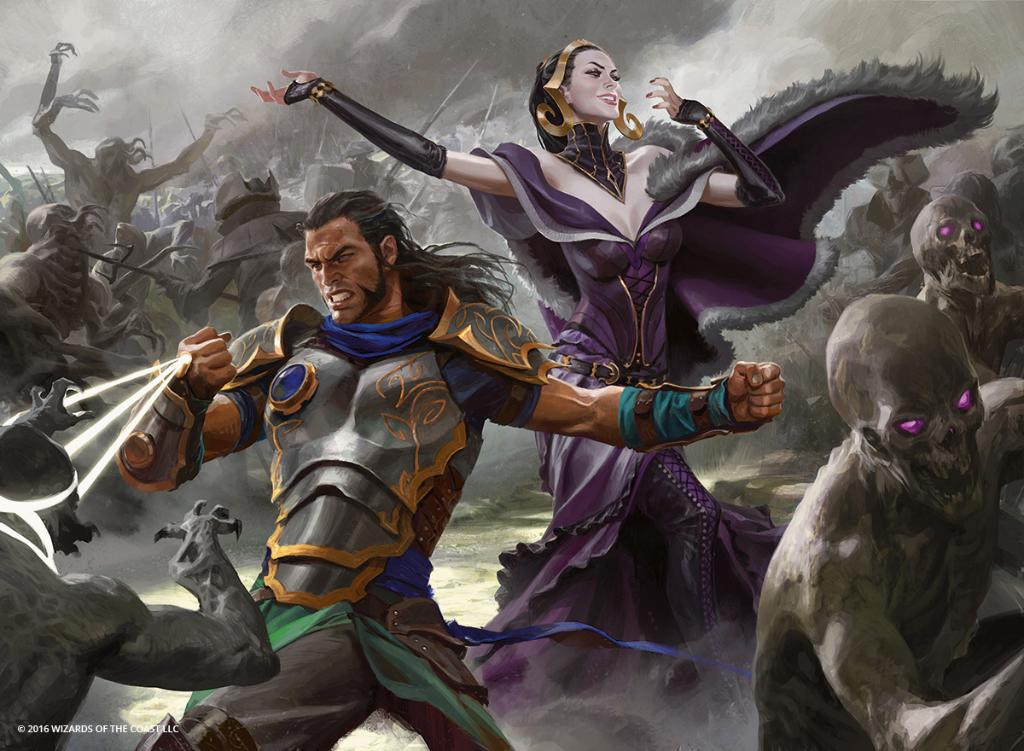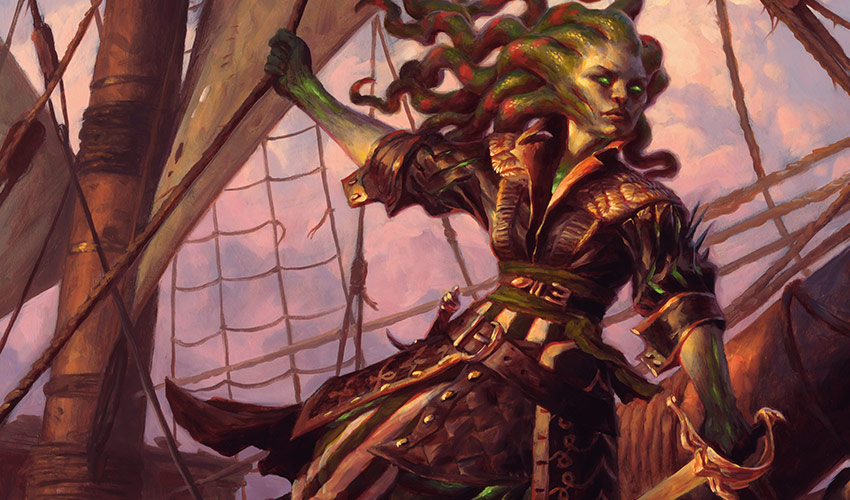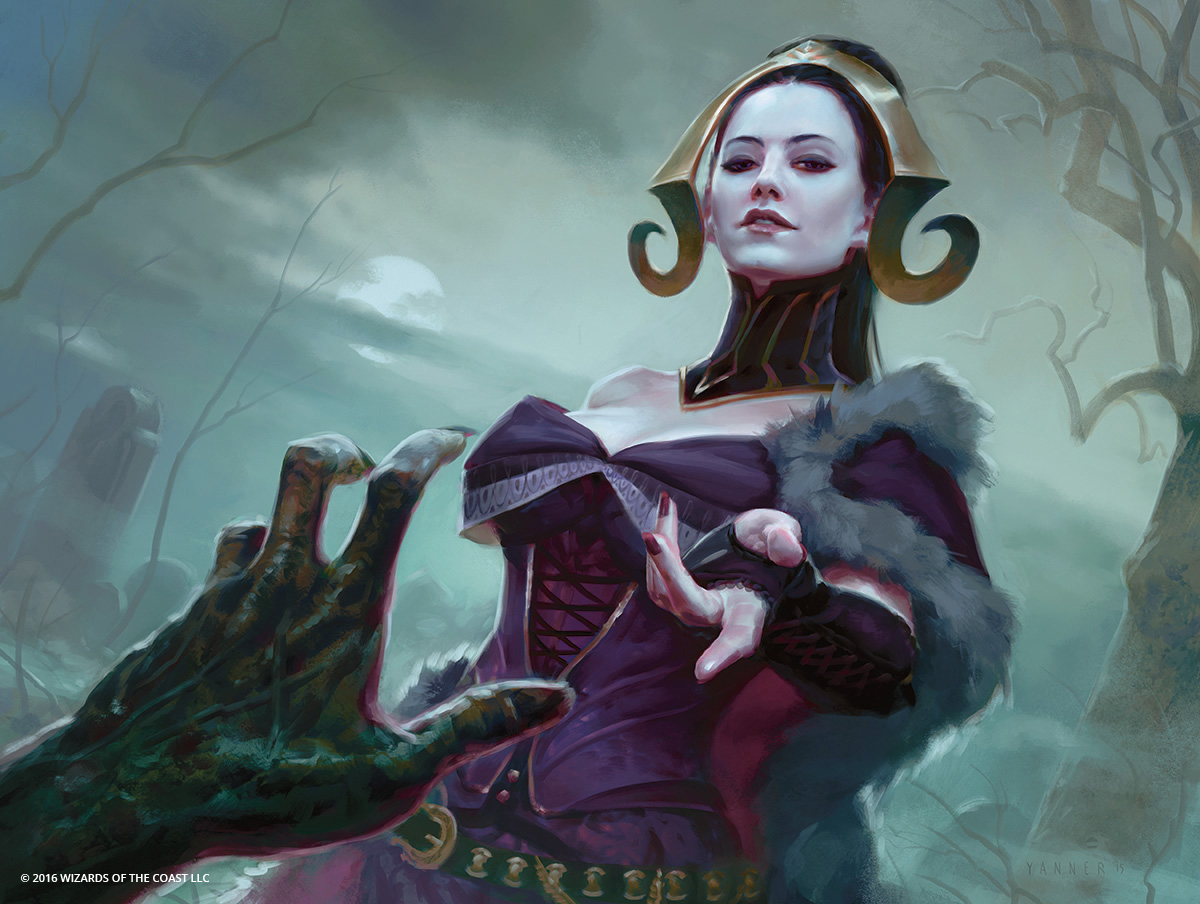War of the Spark: Forsaken is Magic’s newest novel and is a direct sequel to War of the Spark: Ravnica from earlier this year. It picks up in the immediate wake of Bolas’s fall and retells the end of that book from Kaya’s perspective. As such I can’t speak about this book at all without mentioning things that I avoided talking about in my review of War of the Spark: Ravnica.
Specifically, the main plot of Forsaken focuses on the hunt to bring Bolas’s allies to justice, as the new living Guildpact Niv-Mizzet dispatches Ral Zarek to hunt down and kill Tezzeret, Vraska to end Dovin Baan, and Kaya to assassinate Liliana Vess. In any other book I would call following all three quests in a single story ambitious; but after the ridiculous scale of the previous book’s world-spanning war, Forsaken feels surprisingly personal by comparison.
Ultimately this is the greatest piece of praise I can give to Forsaken. War of the Spark: Ravnica had so much going on that dozens of fan favorite characters got reduced to name-drop cameos, and even the core cast of the book mostly spent their time being rushed from plot point to plot point. By contrast, Forsaken has so much more room to explore and expand upon even relatively minor characters. As a result, we learn far more in this book than we did in the last one.
A Spoiler-Free Overview
The backdrop of Bolas’s recent defeat exerts a heavy influence on all of the characters, a litany of trauma that each planeswalker tackles separately. And it hits the core of the Gatewatch particularly hard due to Gideon’s death.
This helps to move the focus on to new (or at least newer) characters. Jace and Chandra play important roles here, but they are more supporting characters. Chandra’s role in particular seems to be setting her up to go on her solo run for the current slate of IDW comics. The only “main” character from the Bolas arc to get a focus here is Liliana.
Speaking of the necromancer, Forsaken spends a significant portion of its length exploring a central question about her. Liliana has youth, immortality, her power, and her soul—so what now? Liliana has been relentlessly pursuing her freedom since she was introduced back in Lorwyn, but never once has she stopped to consider what she’ll do once she achieves her goal.
Going from embracing her own death to suddenly having her every desire granted in the space of a minute leaves her cold. Gideon’s sacrifice in particular is something that she doesn’t know how to deal with, especially since she sees herself as irredeemable.

Our other main characters are much the same as in the first book: Kaya, Teyo, and Rat act as the main protagonists, while Ral and Vraska take on more pronounced roles. Of the three arcs, Kaya’s hunt for Liliana is by far the most interesting, as there’s a lot of narrative depth to be had in two morally grey characters interacting. Ral’s hunt for Tezzeret has little in the way of character growth, but it also holds the most interesting conclusion. (More on that when I get to spoilers later on.) And finally Vraska’s hunt for Dovin Baan is deeply problematic. I can’t really talk about why without getting into spoilers, so for now I’ll just say that Weisman spent this book undoing most of the character growth the Golgari queen has gone through in the past two years.
Weisman’s writing is serviceable. Aside from a few strained metaphors there weren’t any real issues. That being said, it’s also nothing special. Weisman’s character work also varies wildly across the cast. He does his best work with Teyo and Rat, two characters the Author more or less created for this story, and also with the much-beloved Kaya, who was created by Monique Jones for the Conspiracy 2: Take the Throne story. When it comes to the Gatewatch, Vraska, and other characters with established history, his characterizations feel more strained.
In all, I would only recommend this book to someone already invested in Magic’s story and its characters. If you aren’t particularly interested in Liliana, it’s mostly useful to understand the setup for the next year or so of blocks.
In my previous review I’d assumed that the hunts for Tezzeret, Baan, and Liliana would be the focus of the next several blocks, but now it seems that Forsaken will be the only places where those stories are told. This is frustrating for a few reasons, but chief among them is that this book once again killed a planeswalker with zero recognition on the cards. If losing Dack during the actual War of the Spark annoyed you, this is more of the same.
Spoilers Below
This is where I have to get into spoilers. Unlike War of the Spark: Ravnica there are things about Forsaken that I think need to be talked about. The book contains information I have no reason to think will be revealed elsewhere, and I remember how mad it made me when I only found out about Elspeth’s death a full year after it happened. If you plan to read the book, stop here. Otherwise, don’t say I didn’t warn you.

Vraksa and Dovin Baan: Wait, What?
Right, first off: Dovin Baan is dead. The Vedalken was murdered not by Vraska but by one of Lazav’s agents. Crippled and blind, Baan hopped across a rapid series of planes before going to ground back on Ravnica under the assumption that it’s the one plane where planeswalkers would never look for him. That’s a character detail that I really like, especially contrasted against his fellow fugitive’s choice of hiding places.
What I don’t understand is why, when Vraska does manage to hunt him down, she stops and listens long enough for Baan to convince her he’s more valuable alive. Vraska has been through the wringer with liars and manipulators. Her whole arc as Bolas’s pawn taught that some deals aren’t worth taking. She hasn’t finished dealing with the fallout from the choices the Elder Dragon foisted on her, and she lets Baan get under her skin so thoroughly?
All of this is a setup so that when Lazav’s perfect assassin takes Baan out, it gives the Dimir all the information they need to blackmail the queen of the Golgari to do whatever they want. This also manages to fracture (if not outright destroy) her relationship with Jace. Vraska spends the entire book lying to her new lover about the quest Niv-Mizzet gave her, and only tells him what happened after she realizes that she’s compromised. Jace is no stranger to manipulation, and sees that she only brought him in because it forces him to become her accomplice. If Wizards decided they need to keep their main characters single for some reason, fine. But this was a pairing that was literally confirmed in the last three chapters of the last book, which was written by the same author. In-universe, they didn’t even last a week.
It’s the same story with Chandra and Nissa, who after a mutual confession of love at the end of Ravnica, both decide in this book that they were talking platonically. I can’t see why it was undone so quickly. My best guess is that the powers that be didn’t like that Weisman pushed planeswalker’s relationships as far as he did in the first book, and told him to walk it back in the second. Whatever the reason was, it doesn’t read naturally.
Ral and Tezzeret: Setup for Ravnica 4
Anyway, on to Ral and Tezzeret. This hunt was by far the most straightforward. Ral had history with Tezzeret and was well aware of the threat he posed. This turns the arc into a simple matter of track and fight, thought the Wanderer joins Ral and we get to learn a bit more about the enigmatic figure.
Ral and Tezzeret are both inventors, which could have led to an extremely interesting battle of gadgets. Instead, Ral’s powerset got narrowed to blasting things with lightning, while Tezzeret had prepared for exactly that and humiliates the Izzet viceroy before physically beating him to a bloody pulp. He then unhooks his etherium arm and tells Ral to use it as proof of death, as Tezzeret would rather not deal with a cavalcade of planeswalking bounty hunters. However, while Ral initially takes the deal he then tells the truth to Niv-Mizzet, accepting humiliation for his defeat.
At the very end of the book it’s revealed that Tezzeret was in league with Lazav, who was hoping to gain leverage over Ral the same way he did with Vraska. The chapter then ends with an ominous comment about “our plans proceeding apace.” And “four down, six to go.” It seems that Lazav is being set up as the villain of Ravnica 4, as he’s trying to gain a stranglehold on the leadership of all ten guilds.

Kaya and Liliana: Liliana’s Future
That brings me to Kaya and Liliana. Kaya initially has no qualms about assassinating the necromancer, but Teyo is steadfastly against it and Rat is thoroughly undecided. Rat actually accompanies the duo to Dominaria, as it turns out Kaya can carry one individual on her planeswalks by ethereally merging with them. That’s an interesting loophole to give future authors, and I think Rat is the perfect character to be the first nonplaneswalker to shift worlds.
That detail aside, Teyo and eventually Rat manage to bring the two planeswalkers together to talk. Liliana has fallen into abject fatalism by this point, and outright says she’s okay with dying on several occasions. Kaya in turn has no particular reason to spare the necromancer, but with no fondness for Ravnica and having witnessed Liliana’s assault on Bolas she also has no pressing need to kill her. There’s a confrontation with a minion of the Cabal who’s taken over Vess manor by impersonating Liliana. Facing a warped mirror of herself forces Liliana to engage in introspection. With some help, she’s able to let go of the Chain Veil, which Kaya then uses for proof of death.
This is a massive step for Liliana, but what comes after is an even bigger surprise. Taking the name of Ana Iora, she goes undercover and agrees to meet Kaya’s group on Fiora. There they agree to go to Kaya’s home plane of Tolvada to tackle some unspecified challenges. So after everything, it sounds like Liliana is once again committing to the hero business, while the rest of the Gatewatch is disbanding and going their separate ways.
Throughout the story, Nissa renewed her commitment to Zendikar, Ajani left with Teferi and Karn to tackle the Phyrexian problem, the newly-inducted Kaya barely talked to the rest of the Gatewatch after swearing her oath, and Jace and Chandra went their separate ways at the end of the book, with Chandra specifically planning to become a one-woman Gatewatch. And all of this happens like it’s no big deal.
The Gatewatch kinda just collapses, with nobody making a big deal about it. While I know the Gatewatch is a divisive group among some fans, this feels almost unintentional. I genuinely wouldn’t be surprised if they’re back in force by Zendikar Rising.
Conclusion
I went into this book exited to see what comes next. I wanted to like it. I left confused about what they were trying to achieve.
Whether I would recommend this book depends on what a specific reader is looking for. War of the Spark: Forsaken is pointedly not a good introduction to Magic’s ongoing story because of how heavily it leans on the events that came before. But if you’ve been following the Bolas arc and want to see it through to the very end, this book will be your last stop.
As a standalone story, War of the Spark: Forsaken is passable, but it is only truly good if you are deeply invested in Liliana Vess as a character. For people who don’t really cared about Magic’s chief necromancer but are deeply invested in other parts of the story, this book really isn’t for you.
And to be fair, I think that’s a step in the right direction. War of the Spark: Ravnica was a cluttered mess because it was trying to juggle way too many characters and plot points. Magic’s best stories have focused very tightly on one to five characters—in my opinion at least. In fact, my biggest complaints with this book all sprang from the fact that Weisman couldn’t do justice to all the characters he had to fit into the plot. It’s not a bad story by any means, but it’s a bit messy like his first Magic novel, just a little less so.
This article has been updated to correctly attribute the creation of the character Kaya to Monique Jones after incorrectly attributing Greg Weisman.
This article contains affiliate links from which Hipsters of the Coast may make a commission.

